|
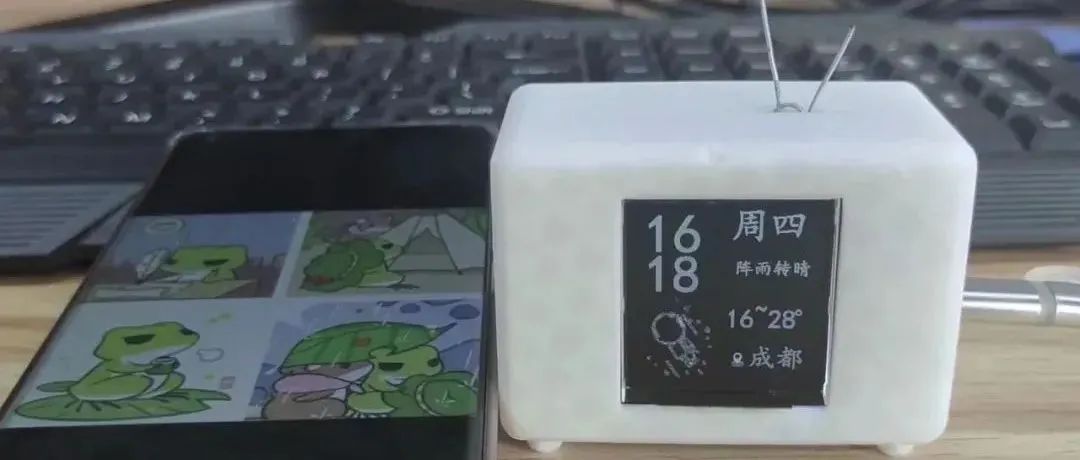
九月一到,就有了秋意,秋意在一个多雾的黎明溜来,到了炎热的下午便不见踪影。它踮起脚尖掠过树顶,染红几片叶子,然后乘着一簇飞掠过山谷离开。秋天已悄悄到来,背上你的行囊,叫上你的小伙伴一起去外面看看缤纷的世界。这不我养的小青蛙已经出去旅行了,它总是会给我发一些它在旅游时候的照片,不过最近在外好像有了艳遇。给大家看看它寄回来的照片。

我每当我看到我这里天气的变好或变差的时候,我都会去看看我的蛙儿子在哪里旅行。
气象站功能:
接受当地时间及当地天气,显示在屏幕上; 使用ESP32-E的电容触摸引脚,切换屏幕显示内容,显示青蛙旅行图片。
一、准备材料
1、硬件材料
ESP32-E主板 3.7v电池 3.7V电池充电器 TFT显示屏
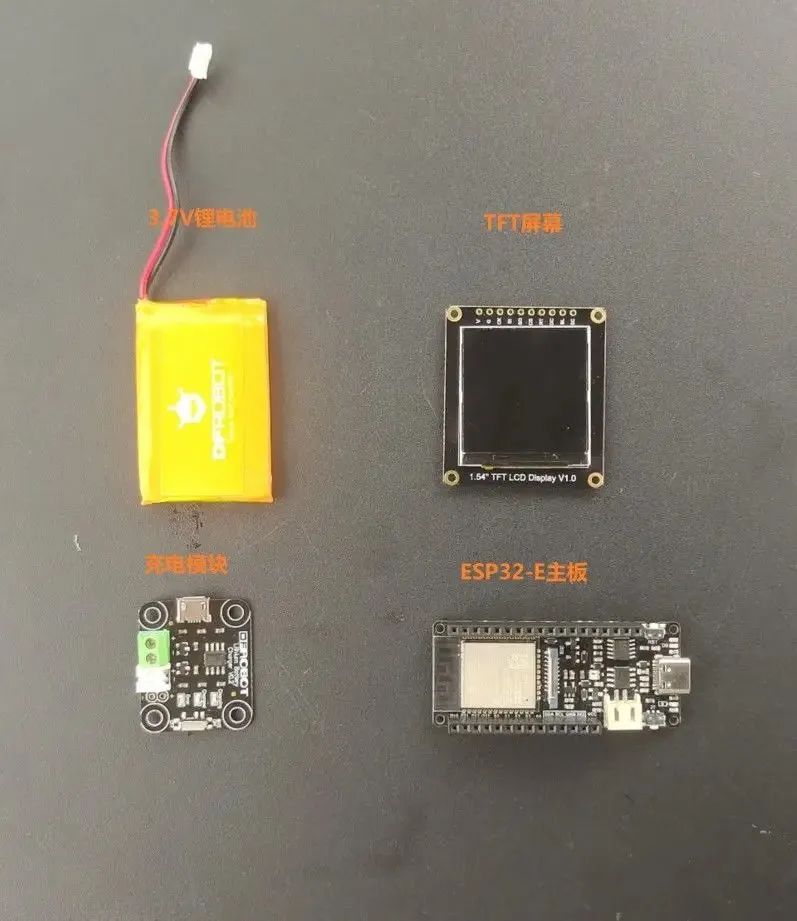
2、外壳打印:
获取图纸链接[1]
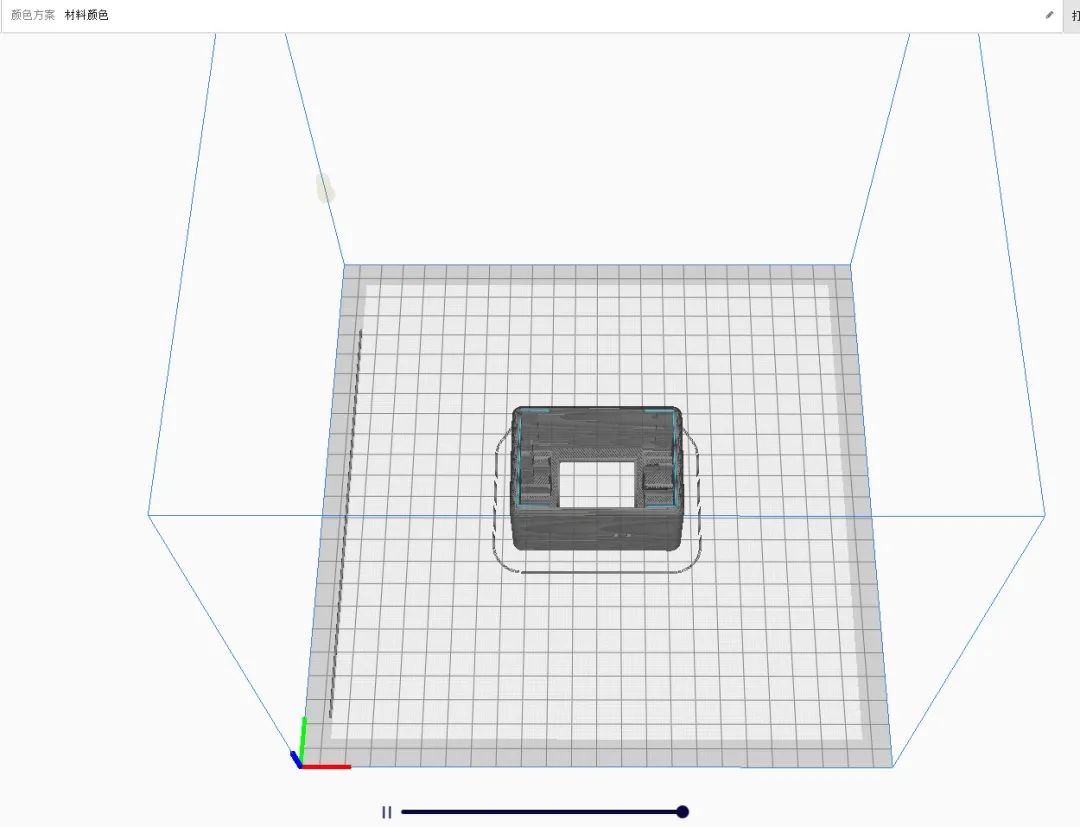
二、制作过程
2.1 将各个模块按下图进行连接
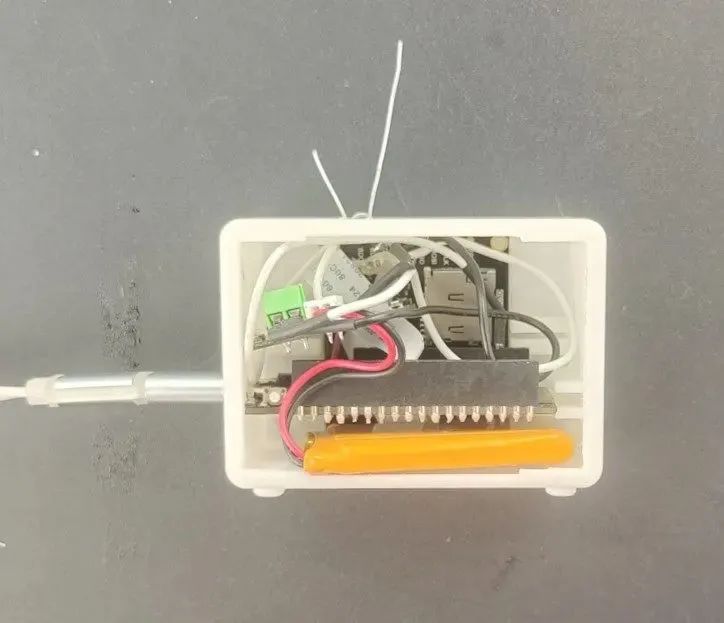
2.2 安装开发板和库文件
关于如何下载本次使用的库文件,DFRobot_GDL库文件[2] 关于如何使用Firebeetle Board-ESP32-E[3] 关于如何下载库文件[4]
三、使用esp32获取网络天气及时间
ESP32同时支持STA以及AP模式的WiFi连接。
STA 模式:ESP32模块通过路由器连接互联网,手机或电脑通过互联网实现对设备的远程控制。 AP 模式:ESP32模块作为热点,实现手机或电脑直接与模块通信,实现局域网无线控制。 STA+AP 模式:两种模式的共存模式,即可以通过互联网控制可实现无缝切换,方便操作。
#include
#include
#include
HTTPClient http;
const char* ssid="dfrobotOffice";
const char* password="dfrobot2011";
const char* ntpServer = "pool.ntp.org";
const long gmtOffset_sec = 28800;
const int daylightOffset_sec = 0;
DynamicJsonDocument doc(1024);
DynamicJsonDocument doc1(1024);
void printLocalTime(){
struct tm timeinfo;
if(!getLocalTime(&timeinfo)){
Serial.println("Failed to obtian time");
return ;
}
Serial.println(&timeinfo,"%A, %B %d %Y %H:%M:%S");
}
void printLocalWeather(){
http.begin("http://www.weather.com.cn/data/cityinfo/101270101.html");
int httpCode = http.GET();
if(httpCode == HTTP_CODE_OK){
String pageData = http .getString();
//Serial.println(pageData);
deserializeJson(doc,pageData);
JsonObject obj = doc.as();
String weatherInfo = obj["weatherinfo"];
deserializeJson(doc1,weatherInfo);
JsonObject obj1 = doc1.as();
String city = obj1["city"];
String temp1 = obj1["temp1"];
String temp2 = obj1["temp2"];
String weather = obj1["weather"];
String cityInfo ="地点:"+ city;
String tempInfo =" 温度: " + temp1 + "~" + temp2;
String cityWeatherinfo = " 天气状况: " + weather;
Serial.println("获得天气情况如下:");
printLocalTime();
Serial.print(cityInfo);
Serial.print(tempInfo);
Serial.println(cityWeatherinfo);
}else{
Serial.println("GET ERR");
}
http.end();
}
void setup() {
Serial.begin(115200);
Serial.printf("Connecting to %s",ssid);
WiFi.begin(ssid,password);
while(WiFi.status()!=WL_CONNECTED){
delay(500);
Serial.print(".");
}
Serial.println(" CONNECTED");
configTime(gmtOffset_sec, daylightOffset_sec, ntpServer);
// printLocalWeather();
}
void loop() {
if(WiFi.status() == WL_CONNECTED){
printLocalWeather();
}else{
Serial.println("WiFi Disconnect");
}
}
说明:本Demo实现了通过WiFi功能获取网络时间以及通过访问国家气象局提供的http://www.weather.com.cn/datalcityinfo/101010100.html来获取天气情况,本接口中“101010100"为城市代码。
注意:该例程需要下载ArduinoJson库,下载方式如下图:
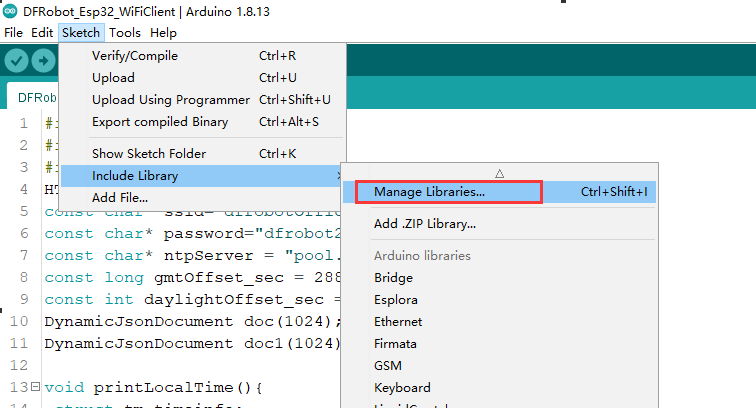
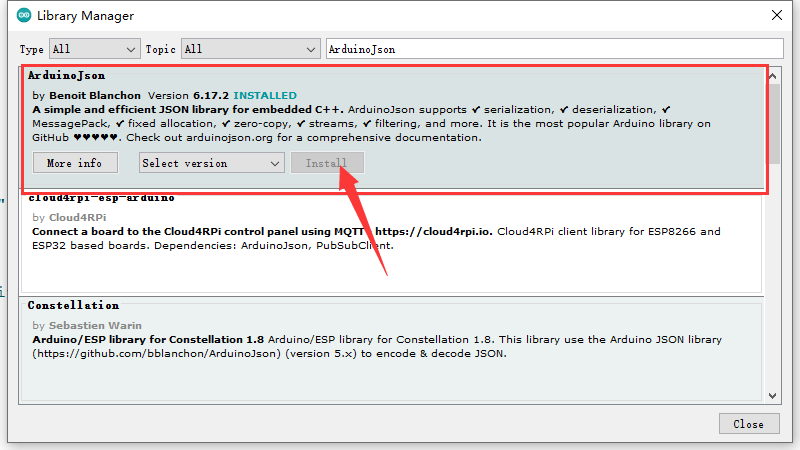
结果
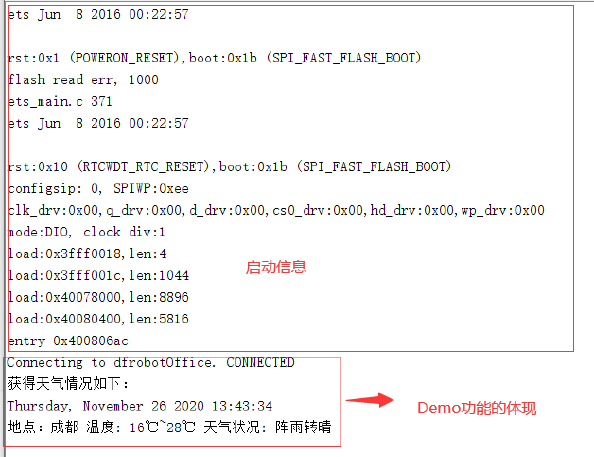
四、添加旋转太空人图片
4.1 旋转太空人的动态图
其实是从动态图里面截取下来的4张图片 通过每100毫秒切换一张图片,达到旋转太空人的形态。

4.2 把图片转换成数组
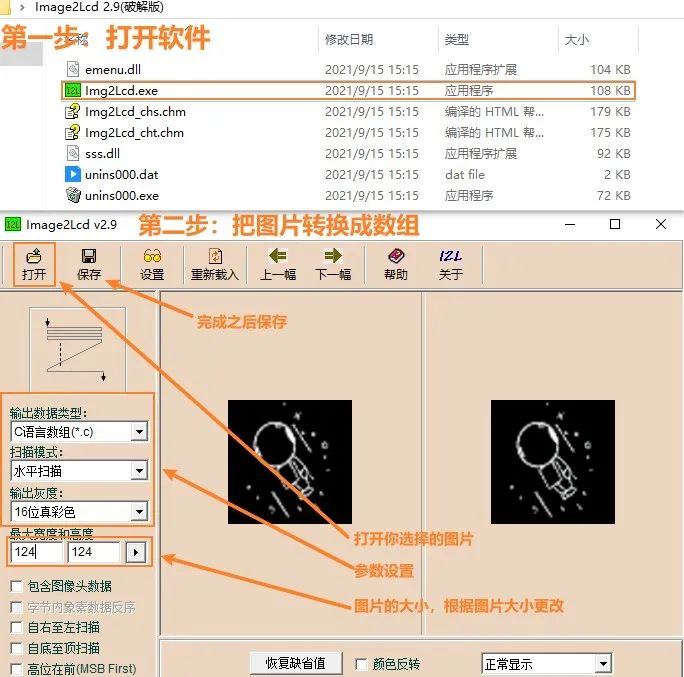
4.3 把图片的数组存放到.h文件下
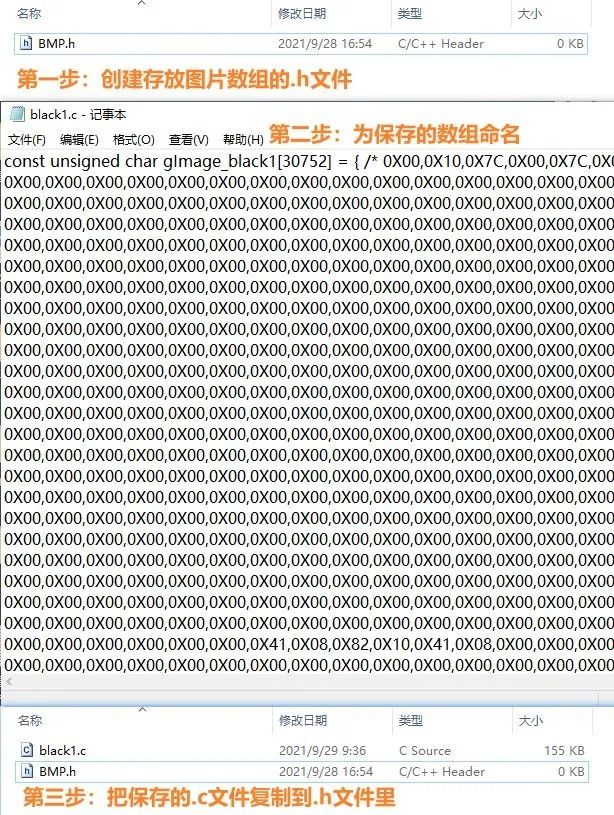
4.4 图片的使用代码如下
#include
#include "BMP.h"
#define TFT_DC D2
#define TFT_CS D6
#define TFT_RST D3
#define PICNUMBER 6
DFRobot_ST7789_240x240_HW_SPI screen(/*dc=*/TFT_DC,/*cs=*/TFT_CS,/*rst=*/TFT_RST);
void setup() {
screen.begin();
}
void loop() {
screen.drawPIC(/*x=*/0,/*y=*/124,/*w=*/124,/*h=*/124,/*bitmap gImage_Bitmap=*/( uint8_t*)gImage_black1);
delay(100);
screen.drawPIC(/*x=*/0,/*y=*/124,/*w=*/124,/*h=*/124,/*bitmap gImage_Bitmap=*/( uint8_t*)gImage_black2);
delay(100);
screen.drawPIC(/*x=*/0,/*y=*/124,/*w=*/124,/*h=*/124,/*bitmap gImage_Bitmap=*/( uint8_t*)gImage_black3);
delay(100);
screen.drawPIC(/*x=*/0,/*y=*/124,/*w=*/124,/*h=*/124,/*bitmap gImage_Bitmap=*/( uint8_t*)gImage_black4);
delay(100);
screen.drawPIC(/*x=*/0,/*y=*/124,/*w=*/124,/*h=*/124,/*bitmap gImage_Bitmap=*/( uint8_t*)gImage_black5);
}
4.5 图片动态展示
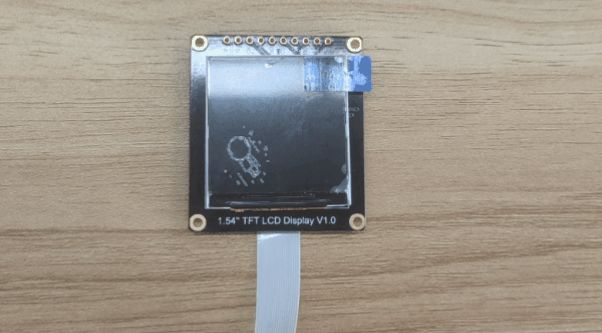
五、把从网络上获取到的天气和时间信息显示在TFT屏幕
5.1 python环境搭建
在使用setup.py脚本生成自定义字体之前,需要做如下准备:
登录网址https://www.python.org/downloads/,下载python3.6及以上版本; 安装完毕后,需要用下列命令安装python第三方依赖包: pip3 install numpy pip install freetype-py pip install chardet
5.2 生成自定义字体
把ttf文件放在库文件的对应ttf文件夹下,这里我提供了一个ttf文件,供大家使用。链接获取[5]:
将TTF字体文件存放在ttf文件夹里,例如:SIMKAI.TTF(简体字 楷体) 在text.txt文件中输入你想生成的字符,例如:你好,世界! 打开config.txt文件,配置生成字体文件的名字前缀和字体大小
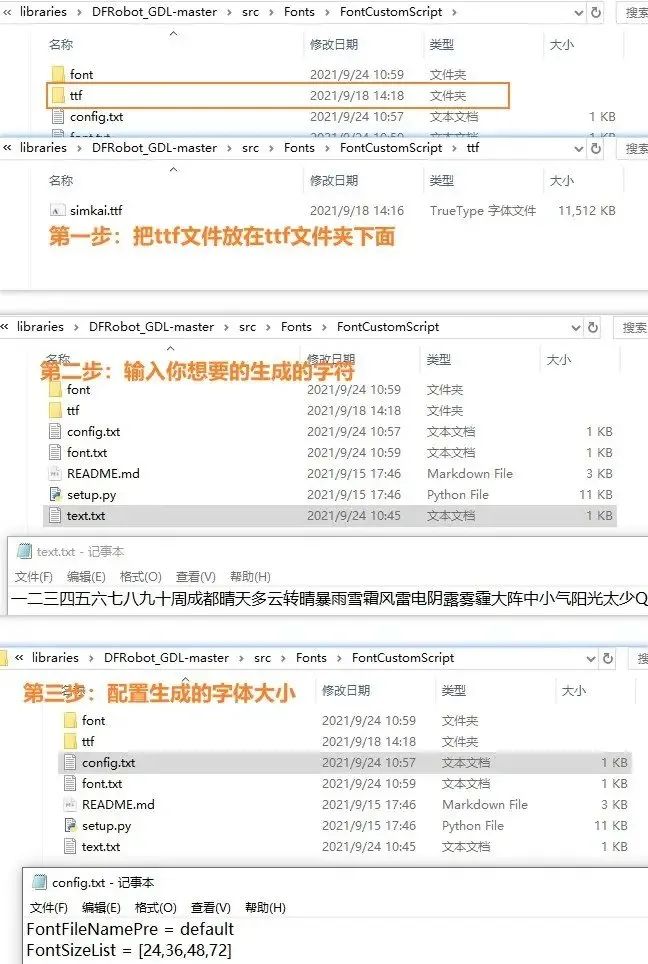
5.3 在屏幕上显示
运行setup.py脚本,会在font文件夹生成一系列后缀名为.h的字体文件,并弹出一个font.txt的文本,再进行以下步骤,即可在屏上显示:你好,世界! 将font文件夹里的文件复制到DFRobot_GDL\src\Fonts\Fonts目录下; 将弹出的font.txt的内容粘贴到DFRobot_GDL\src\Fonts\DFRobot_Font.h文件中; 打开Arduino IDE,构造屏对象,如tft,调用tft.setFont(&SIMKAIFont48pt); 调用tft.println("你好,世界!"),此时即可在屏上显示"你好,世界!"
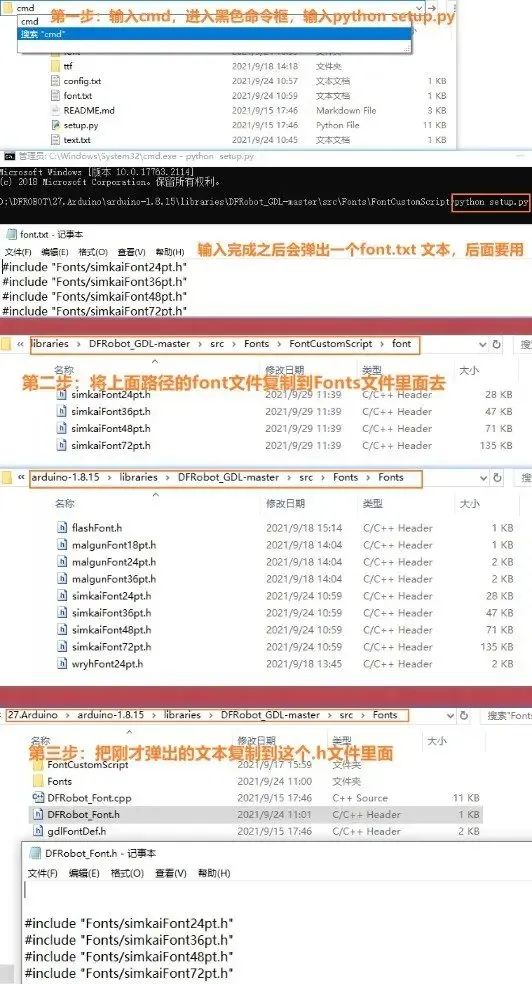
5.4 显示天气和时间的代码如下
#include
#include
#include
#include
#include "BMP.h"
HTTPClient http;
const char* ssid="dfrobotOffice";
const char* password="dfrobot2011";
const char* ntpServer = "pool.ntp.org";
const long gmtOffset_sec = 28800;
const int daylightOffset_sec = 0;
DynamicJsonDocument doc(1024);
DynamicJsonDocument doc1(1024);
#define TFT_DC D2
#define TFT_CS D6
#define TFT_RST D3
#define PICNUMBER 6
String weekDays[]={"周天", "周一", "周二","周三", "周四", "周五", "周六"};
DFRobot_ST7789_240x240_HW_SPI screen(/*dc=*/TFT_DC,/*cs=*/TFT_CS,/*rst=*/TFT_RST);
void setup() {
Serial.begin(115200);
screen.begin();
Serial.printf("Connecting to %s",ssid);
WiFi.begin(ssid,password);
while(WiFi.status()!=WL_CONNECTED){
delay(500);
Serial.print(".");
}
Serial.println(" CONNECTED");
configTime(gmtOffset_sec, daylightOffset_sec, ntpServer);
screen.fillScreen(COLOR_RGB565_BLACK);
}
void printLocalWeather(){
http.begin("http://www.weather.com.cn/data/cityinfo/101270101.html");
int httpCode = http.GET();
if(httpCode == HTTP_CODE_OK){
String pageData = http .getString();
//Serial.println(pageData);
deserializeJson(doc,pageData);
JsonObject obj = doc.as();
String weatherInfo = obj["weatherinfo"];
deserializeJson(doc1,weatherInfo);
JsonObject obj1 = doc1.as();
String city = obj1["city"];
String temp1 = obj1["temp1"];
String temp2 = obj1["temp2"];
String weather = obj1["weather"];
String cityInfo = city;
String tempInfo =temp1 + "~" + temp2;
String cityWeatherinfo =weather;
Serial.println("获得天气情况如下:");
Serial.print(cityInfo);
Serial.print(tempInfo);
Serial.println(cityWeatherinfo);
struct tm timeinfo;
if(!getLocalTime(&timeinfo)){
Serial.println("Failed to obtian time");
return ;
}
Serial.println(&timeinfo, "%F %R %u"); // 格式化输出
//显示天气及时间信息
screen.setFont(&simkaiFont72pt );//Set the font to FreeMono12pt7b
screen.setCursor(/*x=*/15,/*y=*/0);
screen.println(&timeinfo,"%H");
screen.setCursor(/*x=*/15,/*y=*/55);
screen.println(&timeinfo,"%M");
screen.setFont(&simkaiFont72pt );//Set the font to FreeMono12pt7b
screen.setCursor(/*x=*/0,/*y=*/0);
screen.setTextColor(COLOR_RGB565_LGRAY);
screen.setTextWrap(true);
screen.setFont(&simkaiFont48pt );//Set the font to FreeMono12pt7b
screen.setCursor(/*x=*/124,/*y=*/0);
screen.println(weekDays[timeinfo.tm_wday]);
screen.setFont(&simkaiFont24pt );//设置字体大小 为24像素点大小
screen.setCursor(/*x=*/130,/*y=*/70); //设置显示光标
screen.println(cityWeatherinfo);//屏幕显示天气状况,如多云转晴类字样
screen.drawPIC(/*x=*/125,/*y=*/200,/*w=*/24,/*h=*/24,/*bitmap gImage_Bitmap=*/( uint8_t*)gImage_black6);//屏幕显示位置图标
screen.setFont(&simkaiFont36pt );//设置字体大小 为36像素点大小
screen.setCursor(/*x=*/120,/*y=*/135);//设置显示光标
screen.println(tempInfo);//屏幕显示温度信息
screen.setCursor(/*x=*/204,/*y=*/135);
screen.println("°");//显示温度的符号
screen.setCursor(/*x=*/150,/*y=*/190);
screen.println(cityInfo);//屏幕显示你所在城市的位置信息
}else{
Serial.println("GET ERR");
}
http.end();
}
void loop() {
if(WiFi.status() == WL_CONNECTED){
printLocalWeather();
}else{
Serial.println("WiFi Disconnect");
}
}
5.5 显示效果
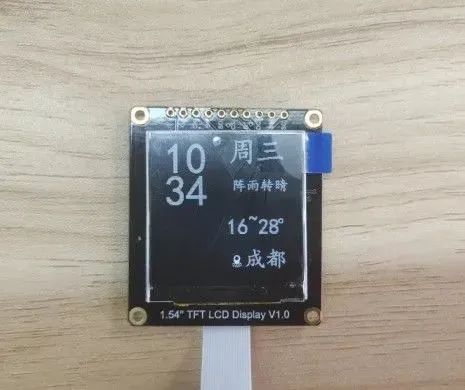
六、使用电容触摸显示青蛙儿子旅行照片
6.1 电容按键
ESP32提供了电容触摸传感器的功能, 共有T0,T2~T9 共 9个touch传感器可用.分别对应引脚4、2、15、13、12、14、27、33、32. 无需设置PinMode,touchRead()返回值为0~255. 触摸强度越大,返回值越小。烧录此例程,将使用4/D12引脚作为触摸按键,并通过串口监视器返回触摸值。
void setup()
{
Serial.begin(9600);
}
void loop()
{
Serial.printf("touch:%d\n",touchRead(4));
}
结果
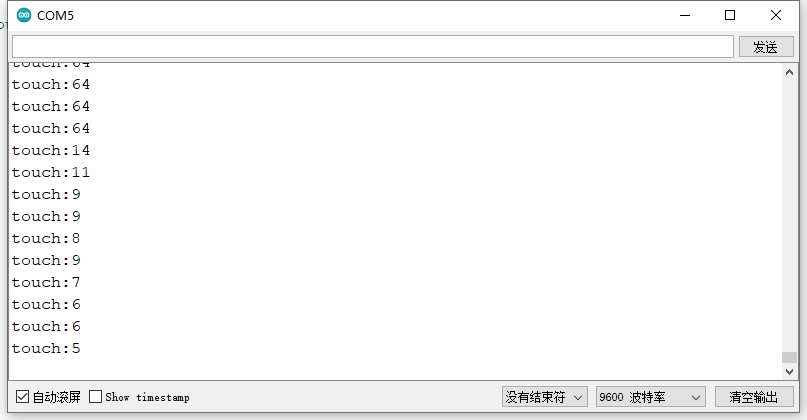
6.2 选择放置的图片

6.3 触摸一次就切换一次图片代码
#include
#include "BMP.h"
#define TFT_DC D2
#define TFT_CS D6
#define TFT_RST D3
#define PICNUMBER 6
uint8_t randNumber;
DFRobot_ST7789_240x240_HW_SPI screen(/*dc=*/TFT_DC,/*cs=*/TFT_CS,/*rst=*/TFT_RST);
uint8_t printfrog(uint8_t number){
switch(number){
case 0:
screen.drawPIC(/*x=*/0,/*y=*/0,/*w=*/240,/*h=*/240,/*bitmap gImage_Bitmap=*/( uint8_t*)gImage_qingwa1);//显示的随机图片
delay(2000);
break;
case 1:
screen.drawPIC(/*x=*/0,/*y=*/0,/*w=*/240,/*h=*/240,/*bitmap gImage_Bitmap=*/( uint8_t*)gImage_qingwa2);
delay(2000);
break;
case 2:
screen.drawPIC(/*x=*/0,/*y=*/0,/*w=*/240,/*h=*/240,/*bitmap gImage_Bitmap=*/( uint8_t*)gImage_qingwa3);
delay(2000);
break;
case 3:
screen.drawPIC(/*x=*/0,/*y=*/0,/*w=*/240,/*h=*/240,/*bitmap gImage_Bitmap=*/( uint8_t*)gImage_qingwa4);
delay(2000);
break;
case 4:
screen.drawPIC(/*x=*/0,/*y=*/0,/*w=*/240,/*h=*/240,/*bitmap gImage_Bitmap=*/( uint8_t*)gImage_qingwa5);
delay(2000);
break;
case 5:
screen.drawPIC(/*x=*/0,/*y=*/0,/*w=*/240,/*h=*/240,/*bitmap gImage_Bitmap=*/( uint8_t*)gImage_qingwa6);
delay(2000);
break;
}
}
void setup() {
Serial.begin(115200);
screen.begin();
}
void loop() {
if(touchRead(4) |
















